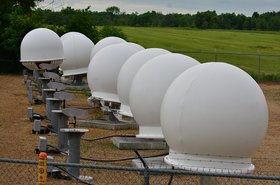As personal and business activities are increasingly intertwined with the online world, the lack of access to reliable, cost-effective broadband network connectivity creates a gulf between underserved and unserved communities and our connected society, creating inequalities, particularly in sparsely populated remote and rural locations.
Submarine cable networks
Although not widely known, upwards of 99 percent of all electronic communications data is carried between continental landmasses over fiber-optic submarine cables that are the size of a common garden hose.
These marvels of electrical, mechanical, and chemical engineering typically span hundreds to thousands of kilometers, with newer submarine cables transporting hundreds of terabits per second.
The cables’ main purpose is to interconnect countries and continents by carrying aggregated inland terrestrial traffic from end users, humans, and machines, so they must be capable of carrying massive amounts of data.
To date, and for the foreseeable future, there is no other communications technology capable of carrying a comparable amount of data over transoceanic distances with similar or better cost efficiency, security, and reliability.
There is simply no “Plan B” to replace submarine cable networks in the near term.
Satellite networks
In sharp contrast to traditional Medium Earth Orbit (MEO) and Geostationary Equatorial Orbit (GEO) satellite networks, Low Earth Orbit (LEO) satellite networks provide significant performance improvements by combining new technologies used in hundreds to thousands of moving satellites placed in orbits much closer to the earth’s surface.
The result? Faster Internet access speeds and lower latency that, in some cases, can rival terrestrial network Internet access technologies, both wireless and wireline, especially in underserved areas.
Broadband services from LEO satellite networks are targeted at underserved and unserved areas where Internet access is of poor quality (for example, legacy dial-up services) or not available.
Users can simply point their antenna at the sky and connect to LEO satellites to get broadband Internet access.
It should be noted that Internet access using such technology can also be deployed on boats, offices, campers, and cell towers when other options are unavailable or of poorer performance and lower quality.
Friends or foes?
Contrary to popular belief, LEO satellite networks, like their traditional MEO and GEO brethren, are not intended (or expected) to directly compete with or outright replace fiber-optic submarine cable networks.
This is because MEO and GEO satellite networks cannot economically scale to the cost-effective information-carrying capacity of submarine cables.
Rather, modern LEO satellite networks will complement the 500+ submarine cables in service today spanning more than 1.4 million kilometers to provide Internet access to areas lacking reliable broadband performance. In terms of users, this is a largely untapped market, although the price points for such markets must be palatable.
Once a subscriber has LEO Internet access, connectivity takes place between the satellite antenna and terminal to one or more satellites, a ground station, and then onwards over a combination of terrestrial and/or submarine networks to data centers hosting content and applications.
LEO satellite networks are just another tool to expand Internet access to cloud content for more communities, making them highly complementary to the multitude of existing and competing wireless and wireline network technologies.
In the case of small island nations that cannot justify or afford a dedicated fiber-optic submarine cable to connect their citizens, an LEO satellite network is a viable Internet access option and, in some cases, the only one.
Island nations can also use satellite networks with a single submarine cable for backup purposes if their cable is severed, say because of the eruption of an undersea volcano or earthquake.
Enterprises implementing Software-Defined Wide Area Network (SD-WAN) technology can benefit from redundant network technologies by using wireline (for example, Passive Optical Networks or PON), fixed wireless access or cellular networks, and new space-based satellite networks.
The combination of these different kinds of network links and services can provide enterprises with improved availability. In short, LEO satellite networks are friends to existing wireless and wireline networks, not foes.
Addressing the digital divide from Space
For the Digital Divide to be properly addressed, Internet access must be expanded to underserved and unserved communities using a variety of traditional and new network technologies.
The key concerns with increased broadband coverage are related to public/private funding and reaching sparsely populated areas.
Rural and remote locales represent a formidable business challenge for traditional wireless and wireline technologies that are best positioned in more densely inhabited regions that share common infrastructure.
LEO satellites provide a new way to bring broadband Internet access to less populated areas by simply shipping equipment to a home where it can be set up in a short period of time. The challenge is making it affordable for the masses.









